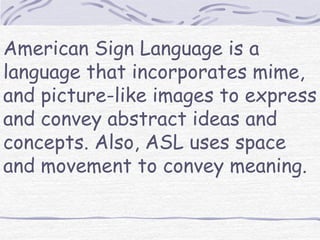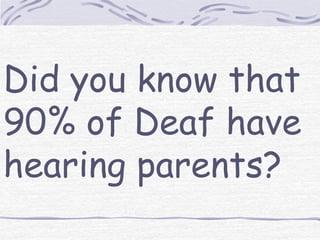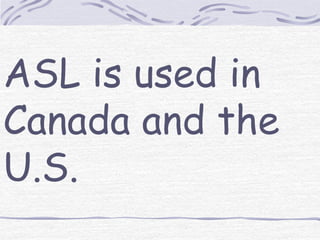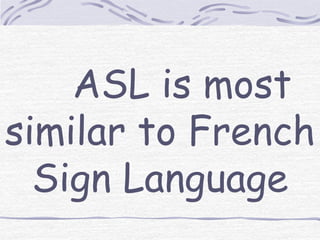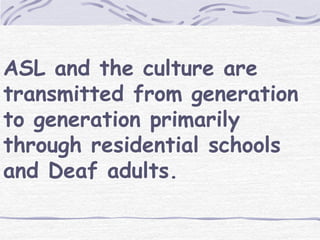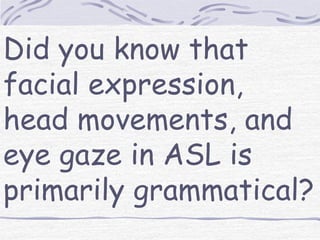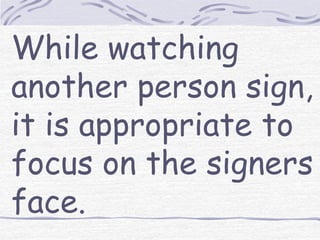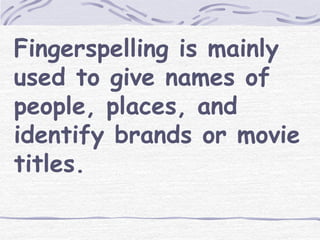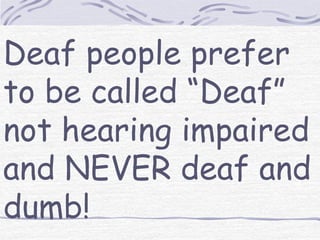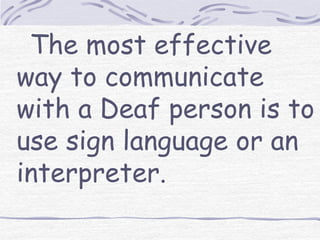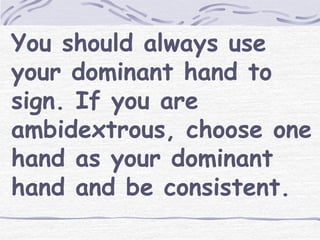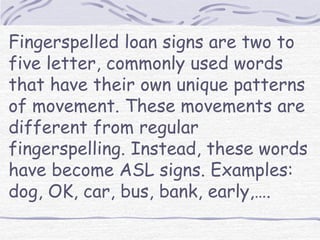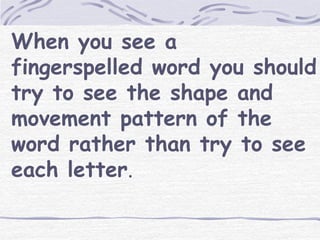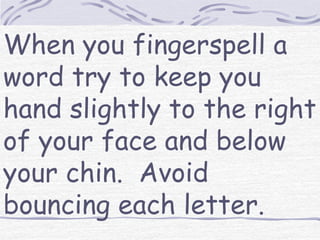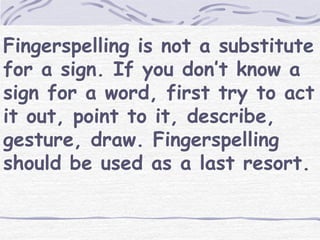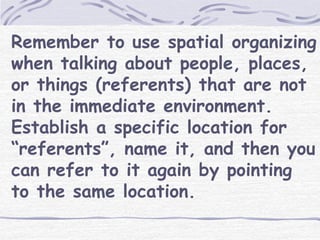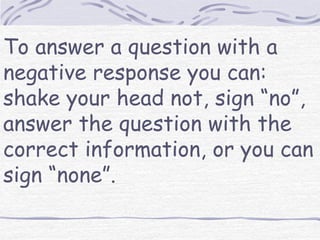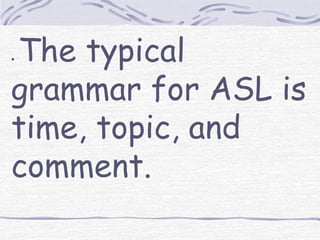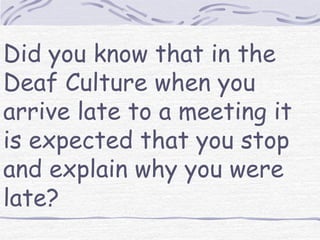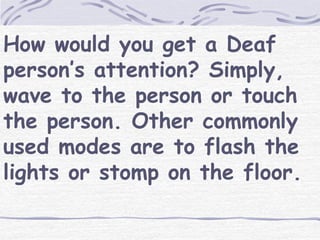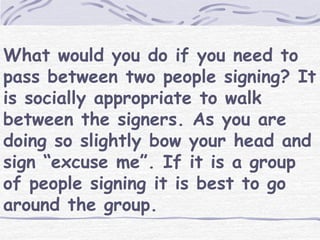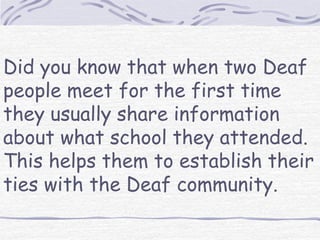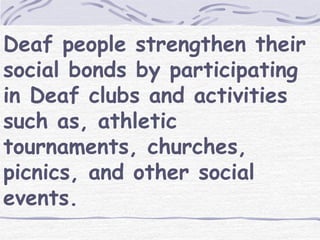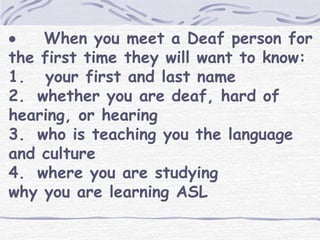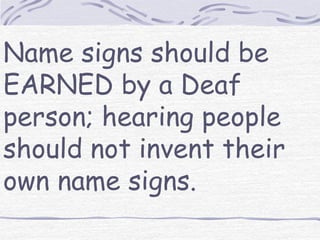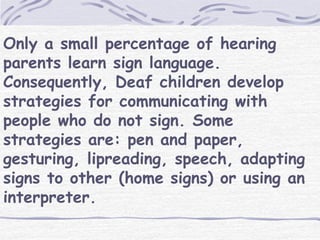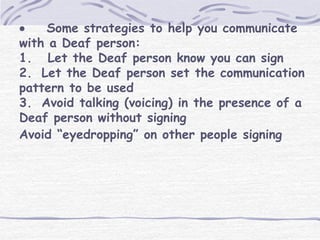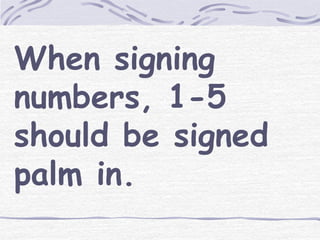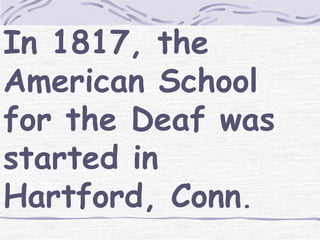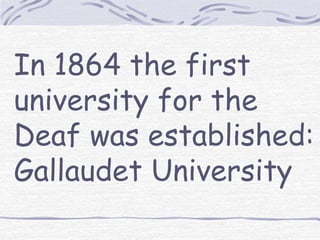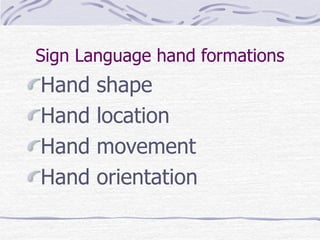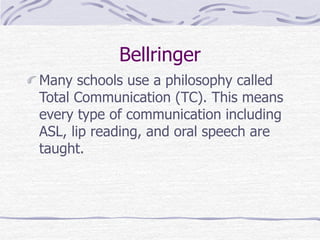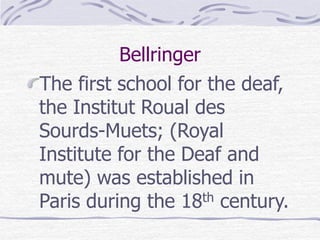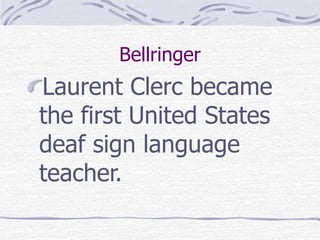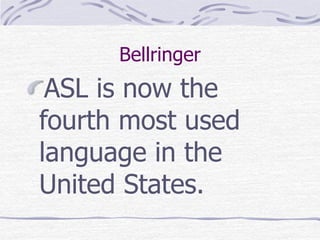Asli bellringers
- 1. American Sign Language is a language that incorporates mime, and picture-like images to express and convey abstract ideas and concepts. Also, ASL uses space and movement to convey meaning.
- 2. Did you know that 90% of Deaf have hearing parents?
- 3. ASL is used in Canada and the U.S.
- 4. ASL is most similar to French Sign Language
- 5. ASL and the culture are transmitted from generation to generation primarily through residential schools and Deaf adults.
- 6. Did you know that facial expression, head movements, and eye gaze in ASL is primarily grammatical?
- 7. While watching another person sign, it is appropriate to focus on the signers face.
- 8. Fingerspelling is mainly used to give names of people, places, and identify brands or movie titles.
- 9. Deaf people prefer to be called âDeafâ not hearing impaired and NEVER deaf and dumb!
- 10. The most effective way to communicate with a Deaf person is to use sign language or an interpreter.
- 11. You should always use your dominant hand to sign. If you are ambidextrous, choose one hand as your dominant hand and be consistent.
- 12. Fingerspelled loan signs are two to five letter, commonly used words that have their own unique patterns of movement. These movements are different from regular fingerspelling. Instead, these words have become ASL signs. Examples: dog, OK, car, bus, bank, early,âĶ.
- 13. When you see a fingerspelled word you should try to see the shape and movement pattern of the word rather than try to see each letter.
- 14. When you fingerspell a word try to keep you hand slightly to the right of your face and below your chin. Avoid bouncing each letter.
- 15. Fingerspelling is not a substitute for a sign. If you donât know a sign for a word, first try to act it out, point to it, describe, gesture, draw. Fingerspelling should be used as a last resort.
- 16. Remember to use spatial organizing when talking about people, places, or things (referents) that are not in the immediate environment. Establish a specific location for âreferentsâ, name it, and then you can refer to it again by pointing to the same location.
- 17. To answer a question with a negative response you can: shake your head not, sign ânoâ, answer the question with the correct information, or you can sign ânoneâ.
- 18. ï·The typical grammar for ASL is time, topic, and comment.
- 19. Did you know that in the Deaf Culture when you arrive late to a meeting it is expected that you stop and explain why you were late?
- 20. How would you get a Deaf personâs attention? Simply, wave to the person or touch the person. Other commonly used modes are to flash the lights or stomp on the floor.
- 21. What would you do if you need to pass between two people signing? It is socially appropriate to walk between the signers. As you are doing so slightly bow your head and sign âexcuse meâ. If it is a group of people signing it is best to go around the group.
- 22. Did you know that when two Deaf people meet for the first time they usually share information about what school they attended. This helps them to establish their ties with the Deaf community.
- 23. Deaf people strengthen their social bonds by participating in Deaf clubs and activities such as, athletic tournaments, churches, picnics, and other social events.
- 24. ï· When you meet a Deaf person for the first time they will want to know: 1. your first and last name 2. whether you are deaf, hard of hearing, or hearing 3. who is teaching you the language and culture 4. where you are studying why you are learning ASL
- 25. Name signs should be EARNED by a Deaf person; hearing people should not invent their own name signs.
- 26. Only a small percentage of hearing parents learn sign language. Consequently, Deaf children develop strategies for communicating with people who do not sign. Some strategies are: pen and paper, gesturing, lipreading, speech, adapting signs to other (home signs) or using an interpreter.
- 27. ï· Some strategies to help you communicate with a Deaf person: 1. Let the Deaf person know you can sign 2. Let the Deaf person set the communication pattern to be used 3. Avoid talking (voicing) in the presence of a Deaf person without signing Avoid âeyedroppingâ on other people signing
- 28. When signing numbers, 1-5 should be signed palm in.
- 29. In 1817, the American School for the Deaf was started in Hartford, Conn.
- 30. In 1864 the first university for the Deaf was established: Gallaudet University
- 31. Sign Language hand formations Hand shape Hand location Hand movement Hand orientation
- 32. Bellringer Many schools use a philosophy called Total Communication (TC). This means every type of communication including ASL, lip reading, and oral speech are taught.
- 33. Bellringer The first school for the deaf, the Institut Roual des Sourds-Muets; (Royal Institute for the Deaf and mute) was established in Paris during the 18th century.
- 34. Bellringer Laurent Clerc became the first United States deaf sign language teacher.
- 35. Bellringer ASL is now the fourth most used language in the United States.

